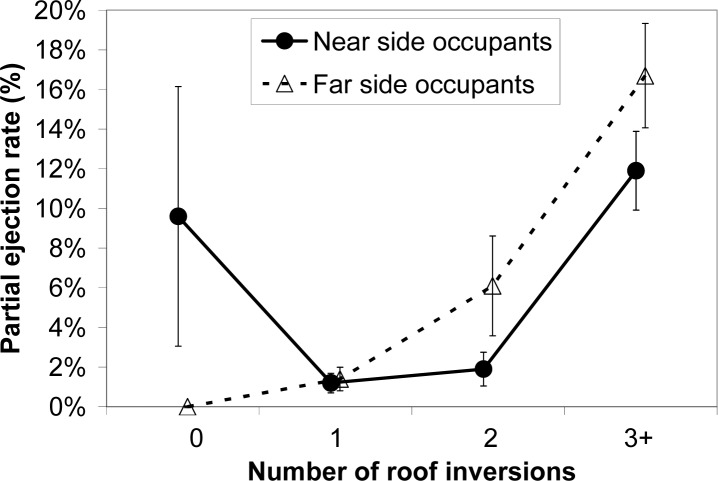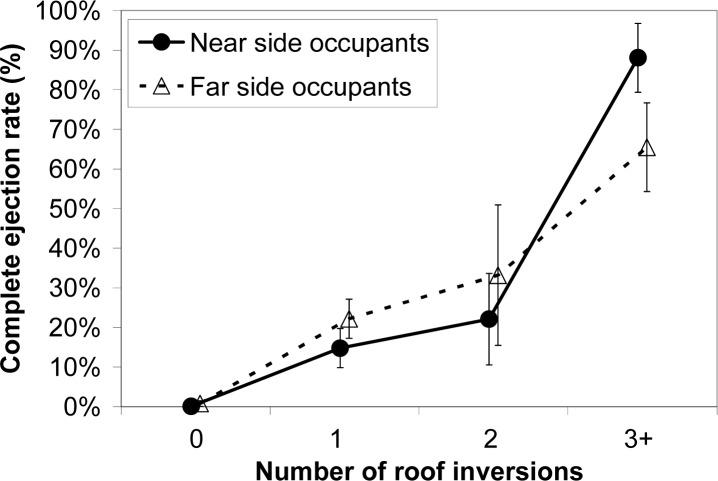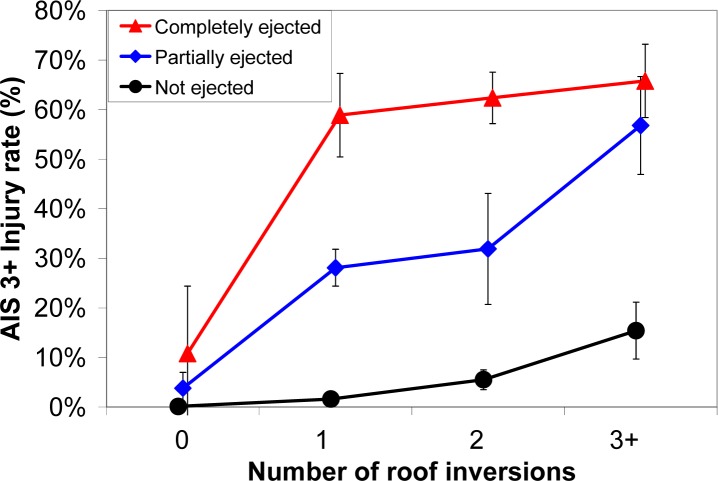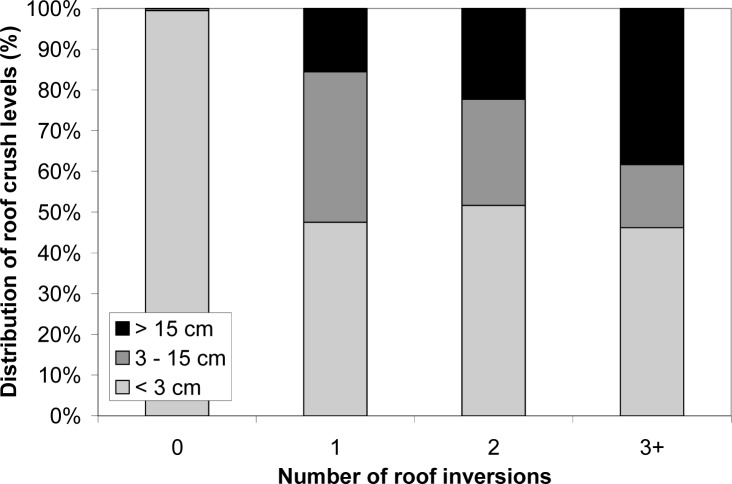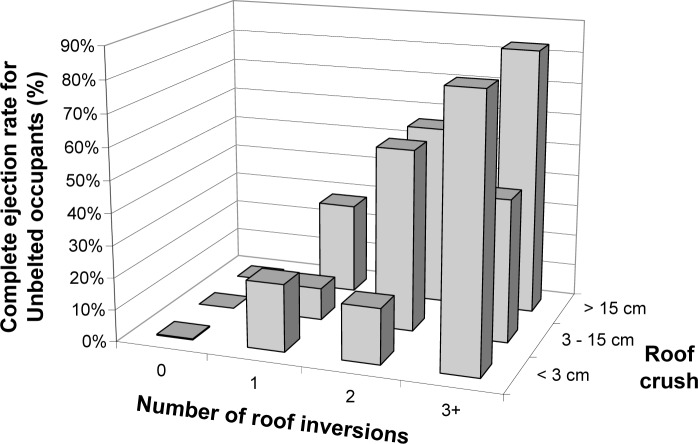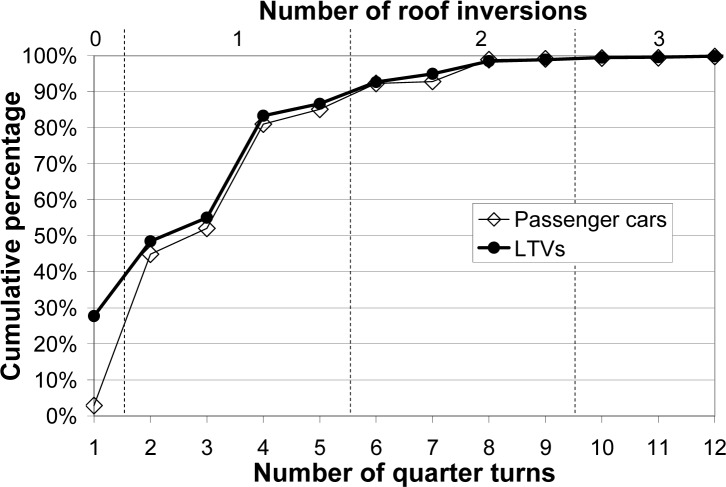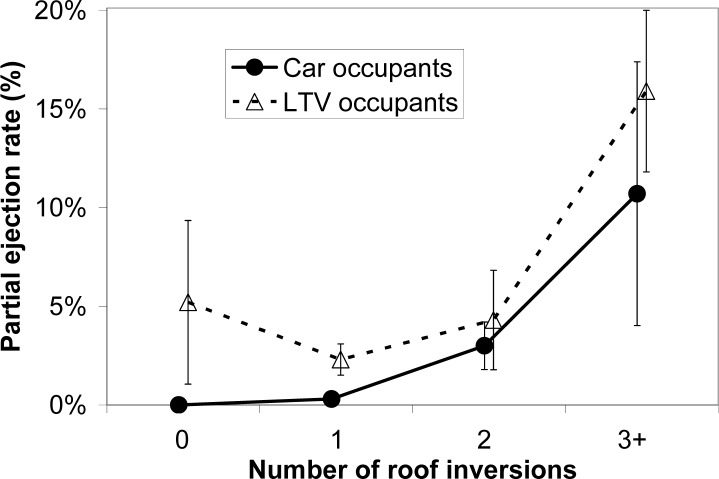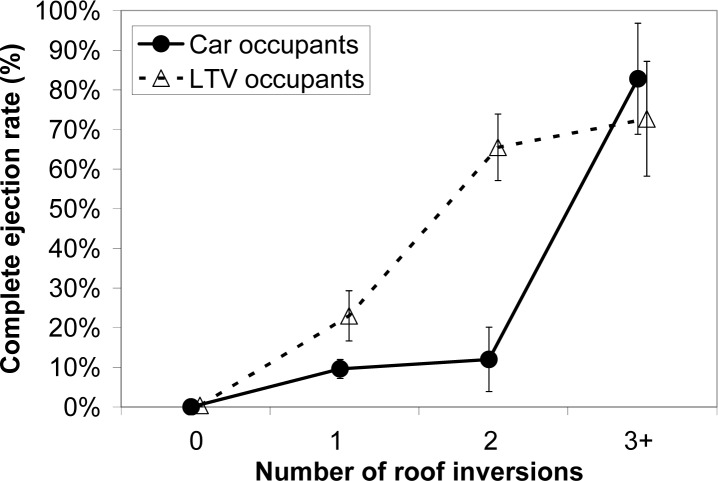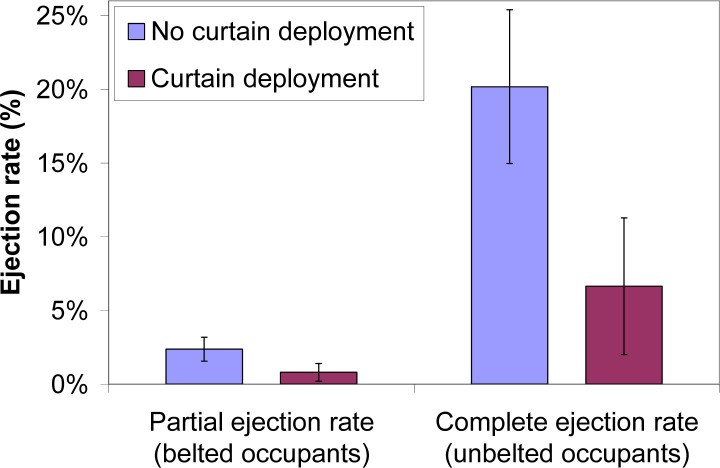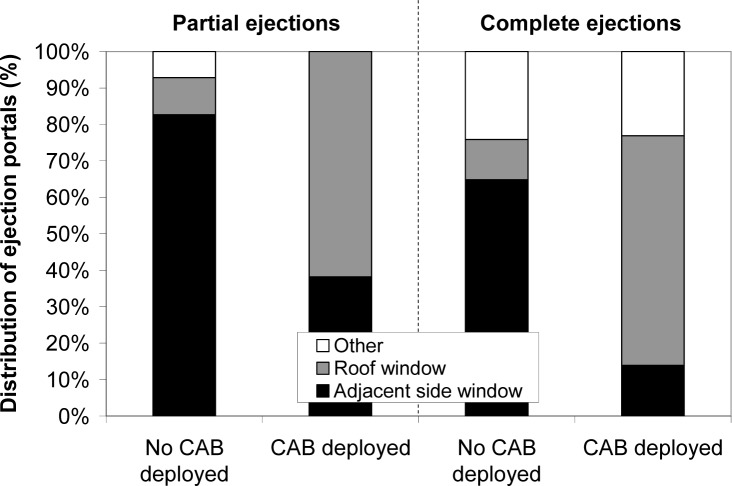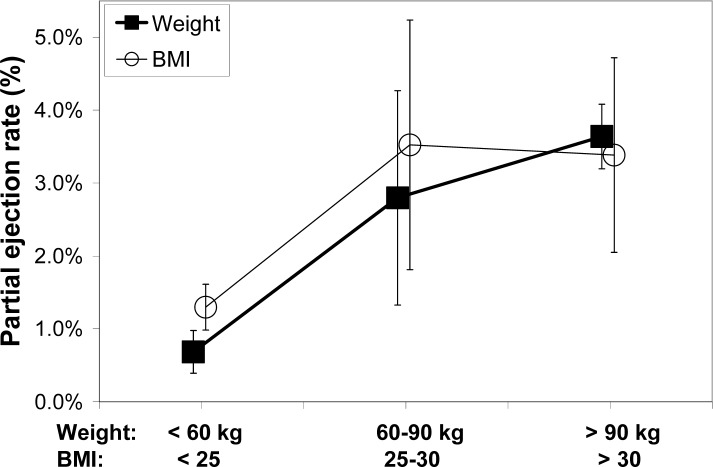Abstract
Ejection greatly increases the risk of injury and fatality in a rollover crash. The purpose of this study was to determine the crash, vehicle, and occupant characteristics that affect the risk of ejection in rollovers. Information from real world rollover crashes occurring from 2000 – 2010 was obtained from the National Automotive Sampling System (NASS) in order to analyze the effect of the following parameters on ejection risk: seatbelt use, rollover severity, vehicle type, seating position, roof crush, side curtain airbag deployment, glazing type, and occupant age, gender, and size. Seatbelt use was found to reduce the risk of partial ejection and virtually eliminate the risk of complete ejection. For belted occupants, the risk of partial ejection risk was significantly increased in rollover crashes involving more roof inversions, light trucks and vans (LTVs), and larger occupants. For unbelted occupants, the risk of complete ejection was significantly increased in rollover crashes involving more roof inversions, LTVs, far side occupants, and higher levels of roof crush. Roof crush was not a significant predictor of ejection after normalizing for rollover severity. Curtain airbag deployment was associated with reduced rates of partial and complete ejection, but the effect was not statistically significant, perhaps due to the small sample size (n = 89 raw cases with curtain deployments). A much greater proportion of occupants who were ejected in spite of curtain airbag deployment passed through the sunroof and other portals as opposed to the adjacent side window compared to occupants who were ejected in rollovers without a curtain airbag deployment. The primary factors that reduce ejection risk in rollover crashes are, in generally decreasing order of importance: seatbelt use, fewer roof inversions, passenger car body type, curtain airbag deployment, near side seating position, and small occupant size.
INTRODUCTION
Despite widespread use of seatbelts and electronic stability control, injuries and fatalities due to occupant ejection in rollover crashes remain a significant problem. Completely ejected occupants make up half of all fatalities resulting from rollover crashes (Funk and Luepke, 2008). Compared to occupants who remain in the vehicle, the risk of serious injury is increased by a factor of 20 and the risk of fatality is increased by a factor of 91 in occupants who are completely ejected during a rollover crash (Funk et al., 2012). The influence of ejection on injury and fatality risk in rollover crashes dwarfs the effects of all other factors.
Although many epidemiological studies have investigated risk factors for injury in rollover crashes (Parenteau and Shah, 2000; Bedewi et al., 2003; Digges et al., 2003; Moore et al., 2005; Gloeckner et al., 2006; Brumbelow et al., 2009; Funk et al., 2012), relatively few have focused on factors that affect the risk of ejection. Potential risk factors can be identified by considering the dynamics of occupant ejection in rollover crashes. In order to remain inside a rolling vehicle, an occupant must follow a curving path. Newton’s first law of motion dictates that centripetal force is required to make an object follow a curving path. For an occupant in a rolling vehicle, centripetal force can be provided by the seatbelt and/or various structures on the vehicle’s perimeter, such as the door, window glass, pillars, roof rail, or roof. If an occupant is not belted, the vehicle perimeter is often unable to apply sufficiently large centripetal forces to the occupant, and the occupant passes through a window opening and achieves free flight. Once ejected, the occupant is at risk of injury from striking the ground at a high speed or being crushed by the rolling vehicle (Funk et al., 2007).
Based on the physics of occupant ejection, any factor that increases the restraining force acting on the occupant or decreases the centripetal force required to stay inside the vehicle has the potential to reduce the risk of ejection. For example, it has long been recognized that seatbelt use virtually eliminates that risk of complete ejection in any kind of crash because the seatbelt is capable of applying very high levels of restraining force. Seatbelt use also reduces the risk of partial ejection, although it does not eliminate it (Parenteau and Shah, 2000). Conversely, several studies have found that roll severity (as measured by the number of quarter turns or roof inversions) greatly affects the risk of ejection, with relatively few occupants being ejected in crashes involving less than one roll and the majority of unbelted occupants being ejected in multi-roll events (Digges and Eigen, 2003; Moore et al., 2005; Gloeckner et al., 2006; Atkinson et al., 2010). This finding is consistent with the physics of rollovers, because crashes with more rolls involve higher roll rates and therefore require larger centripetal forces to keep occupants inside the vehicle.
The effects of other factors can be evaluated similarly. Higher ejection rates have been reported in light trucks and vans (LTVs) compared to passenger cars (Bedewi et al., 2003; Atkinson et al., 2010). Akinson et al. (2010) attributed this finding to LTVs being involved in generally higher severity rollovers than passenger cars. Although it might be hypothesized that occupant factors could affect ejection rates, no such associations were found by Atkinson et al. (2010). Brumbelow et al. (2009) found that ejection rates were lower in vehicles with stronger roofs, which they attributed to less glass breakage. Although it is not clear why, seating position has also been found to have a modest effect on ejection risk, with higher ejection rates reported for far side vs. near side occupants (Gloeckner et al., 2006) and drivers vs. right front passengers (Atkinson et al., 2010).
Of particular interest to crash safety researchers is the effect of vehicle safety systems designed to mitigate ejection by providing restraining force at the window openings. Rollover-activated side curtain airbags, for example, are designed specifically to reduce the incidence of partial ejection in belted occupants (Takahashi et al., 2003). It has also been suggested that laminated glazing in side windows may reduce the incidence of occupant ejection (Giavatto, 2003). Due to the relatively small number of vehicles equipped with these countermeasures, their performance in the field has not yet been statistically evaluated. The purpose of this study was to identify the various crash, vehicle, and occupant characteristics that influence the risk of ejection in real world rollover crashes using the most current data available.
METHODS
Data from field rollover crashes were obtained from the National Automotive Sampling System-Crashworthiness Data System (NASS-CDS), which contains a large population-based sample linking injury outcomes with detailed crash information. NASS-CDS cases from 2000–2010 in which rollover was the most harmful event were studied. In multiple event crashes, the most harmful event was identified using the “accident event sequence (highest)” variable (NASS manual, 2010). Compared to considering only single-event rollovers, including all crashes in which rollover was the most harmful event effectively doubles the sample size without contaminating the results with harmful events that occurred during the non-rollover portion of the accident sequence (Funk et al., 2012). NASS cases were excluded in the present study if belt use, ejection status, or the number of quarter turns was unknown, because these were felt to be critical parameters. In order to focus our analysis on the modern passenger vehicle fleet, cases involving heavy trucks, pre-1995 model year vehicles, or passive seatbelt systems were excluded. End-over-end rollovers were excluded from the analysis because of their rarity and unusual dynamics. In order to study a consistent restraint configuration, the occupant pool was limited to those 16 years of age and older seated in an outboard seating position in the first two rows. These inclusion criteria yielded 3060 raw case occupants. In accordance with NASS-CDS recommendations, weighting factors were applied to the data in order to obtain nationally representative estimates (NASS manual, 2010). The weighted sample size was approximately 1.2 million occupants (Table 1).
Table 1.
Sample sizes
| Raw | Weighted | |
|---|---|---|
| All occupants | 3060 | 1,169,470 |
| Partial ejections | 201 | 29,722 |
| Belted | 133 | 23,918 |
| Unbelted | 68 | 5804 |
| Complete ejections | 381 | 30,798 |
| Belted | 5 | 334 |
| Unbelted | 376 | 30,464 |
Complete and partial ejection rates were calculated separately as a function of various crash and occupant characteristics, including seatbelt use, rollover severity, vehicle type, seating position, roof crush, side curtain airbag deployment, glazing type, and occupant age, gender, height, weight, and body mass index. When evaluating seatbelt use, complete and partial ejection rates were calculated with respect to all occupants. However, for all other parameters, partial ejection rates were calculated with respect to belted occupants only and complete ejection rates were calculated with respect to unbelted occupants only. When evaluating rollover severity, the number of quarter turns was aggregated by the number of roof inversions (0 roof inversions = 1 quarter turn, 1 roof inversion = 2–5 quarter turns, 2 roof inversions = 6–9 quarter turns, and 3+ roof inversions = 10 or more quarter turns) in order to increase the sample size of each severity group (Digges and Eigen, 2003).
Vehicle type was aggregated into two categories: passenger cars and LTVs (SUVs, pickups, and vans). Vertical roof crush was aggregated into three categories: < 3 cm, 3–15 cm, and > 15 cm. Side curtain airbag deployment was determined using the ROOFBAG variable in NASS. Curtain airbags deployed adjacent to 89 of the raw case occupants. Each of these case files was individually studied to determine whether the curtain airbags were rollover-sensed or side impact-sensed based on the make, model, and model year of the vehicle.
Nonparametric univariate analyses were conducted using the weighted data. Since the NASS-CDS dataset is a non-random sample, the sampling stratification must be taken into account when calculating standard errors and p-values. This was accomplished using the survey procedures within the Statistical Analysis Software (SAS, Cary, NC). When comparing the effects of two factors that were correlated with each other, the relative importance of each factor was evaluated by comparing model fits of univariate and multivariate logistic regression analyses.
RESULTS
Of all the parameters studied, seatbelt use and rollover severity had by far the most dramatic effects on ejection rates (Table 2). The overall rate of seatbelt use in this study was 87%. Seatbelt use virtually eliminated complete ejections (99.8% effectiveness, 95% CI: 99.3% – 100%) and substantially reduced the rate of partial ejections (38% effectiveness; 95% CI: −64% – 76%). There were only 5 raw case occupants who were belted and completely ejected. In three of the cases, the seatback was substantially reclined. In another case, the shoulder portion of the seatbelt had been placed behind the seatback. In the remaining case, there was a potential miscoding. The occupant was coded as belted in the tabular data output but coded as unbelted in the individual case narrative.
Table 2.
Partial ejection rates in belted occupants and complete ejection rates in unbelted occupants as a function of various parameters (*p < 0.05). †Ejection rates as a function of belt use were calculated with respect to all occupants.
| Partial ejection | Complete ejection | |
|---|---|---|
| Belt use† | * | |
| Belted | 2.4% | 0.03% |
| Unbelted | 3.8% | 20% |
| # of roof inversions | * | * |
| 0 | 4.9% | 0.3% |
| 1 | 1.3% | 18% |
| 2 | 3.9% | 28% |
| 3+ | 14.1% | 77% |
| Vehicle type | * | * |
| Passenger cars | 0.7% | 11% |
| Light trucks and vans | 3.5% | 27% |
| Seating position | ||
| Near side | 2.8% | 16% |
| Far side | 1.8% | 25% |
| Roof crush | * | |
| < 3 cm | 2.7% | 17% |
| 3 – 15 cm | 1.4% | 17% |
| > 15 cm | 3.1% | 38% |
| Curtain airbag deployment | ||
| No | 2.4% | 20% |
| Rollover-sensed | 0.5% | 19% |
| Side impact-sensed | 1.3% | 3% |
| Occupant age | ||
| 16 – 24 yrs | 1.3% | 20% |
| 25 – 49 yrs | 1.6% | 19% |
| 50+ yrs | 8.4% | 25% |
| Occupant height | ||
| < 160 cm | 0.7% | 9% |
| 160 – 180 cm | 3.3% | 25% |
| > 180 cm | 1.9% | 20% |
| Occupant weight | * | * |
| < 60 kg | 0.7% | 11% |
| 0 – 90 kg | 2.8% | 33% |
| > 90 kg | 3.6% | 13% |
| Occupant BMI | * | |
| < 25 | 1.3% | 20% |
| 25 – 30 | 3.5% | 22% |
| > 30 | 3.4% | 18% |
| Occupant gender | ||
| Male | 1.6% | 20% |
| Female | 3.4% | 19% |
The rate of ejection generally increased monotonically with rollover severity. A notable exception was the high rate of partial ejections coded when the vehicle came to rest on the side where the occupant was seated. When aggregating by number of roof inversions, this effect was evident for near side occupants in quarter roll events (Figure 1). This subgroup alone comprised 34% of the total number of weighted partial ejections. Otherwise, ejection rates were generally higher for far side occupants than near side occupants, and for drivers compared to right front passengers (analysis not shown). These trends were more consistent for complete ejections (Figure 2). Very high ejection rates were observed in rollovers with 3 or more roof inversions, which comprised only 1.0% of the rollovers studied. The rate of serious (AIS 3+) injury also increased monotonically with rollover severity for both nonejected and ejected occupants (Figure 3).
Figure 1.
Partial ejection rates (± 1 SE) among belted occupants for near and far side occupants as a function of rollover severity.
Figure 2.
Complete ejection rates (± 1 SE) among unbelted occupants for near and far side occupants as a function of rollover severity.
Figure 3.
Serious (AIS 3+) injury rates (± 1 SE) as a function of ejection status and rollover severity.
Vertical roof crush levels > 15 cm were associated with a significantly higher rate of complete ejection among unbelted occupants in a univariate analysis (Table 2). However, roof crush was highly correlated with rollover severity (Figure 4). When complete ejection rates were stratified by both roof crush and the number of roof inversions, it was observed that complete ejection rates generally increased with the number of roof inversions at all levels of roof crush, but higher levels of roof crush were not associated with higher rates of complete ejection in three out of the four rollover severities (Figure 5). In univariate logistic regression analyses, both rollover severity and roof crush were statistically significant predictors of ejection, although rollover severity was a better predictor than roof crush based on the Somers’ D-statistic and the area under the receiver-operator characteristic (ROC) curve. A multivariate logistic regression model incorporating both rollover severity and roof crush was superior to the univariate roof crush model, but worse than the univariate rollover severity model. Therefore, we conclude that roof crush was not independently associated with higher rates of complete ejection in unbelted occupants after normalizing for rollover severity.
Figure 4.
Correlation between rollover severity and roof crush.
Figure 5.
Complete ejection rates in unbelted occupants after stratifying roof crush by the number of roof inversions.
A similar analysis was conducted to determine whether the dramatically higher ejection rates observed in LTVs compared to passenger cars might also be at least partially attributable to LTVs being involved in more serious rollovers. Overall, the distribution of rollover severities was actually less severe in LTVs because they were involved in a higher proportion of quarter roll events and a lower proportion of half roll events compared to passenger cars (Figure 6). The distribution of crashes having 3 or more quarter turns was quite similar between vehicle types. If quarter roll events were completely ignored on the basis that they present a low risk of ejection, then the distribution of rollovers would be greatly skewed towards higher severity crashes in LTVs compared to passenger cars. After stratifying ejection rates for both vehicle type and rollover severity, it was found that partial and complete ejection rates were consistently higher in LTVs than passenger cars at all levels of rollover severity (Figures 7 and 8). Therefore, we conclude that vehicle type was independently associated with ejection even after normalizing for rollover severity.
Figure 6.
Correlation between rollover severity and vehicle type.
Figure 7.
Partial ejection rates (± 1 SE) in belted occupants after stratifying vehicle type by number of roof inversions.
Figure 8.
Complete ejection rates (± 1 SE) in unbelted occupants after stratifying vehicle type by number of roof inversions.
Side curtain airbag deployments were relatively rare in our dataset, occurring in only 1.3% of rollover crashes (89 raw cases). The cases were roughly evenly split between curtain airbags that were triggered by a rollover sensor (48 raw cases) and curtain airbags that were triggered by a side impact sensor (41 raw cases). Although we hypothesized that the rollover-sensed curtain airbag deployments would mitigate ejection more effectively than the side impact-sensed deployments, this effect was only observed in the case of partial ejections, and no statistically significant results were obtained (Table 2). Due to the small sample size, all curtain airbag deployments were grouped in order to estimate their effectiveness. Overall, curtain airbag deployments were 66% effective (95% CI: −150% – 92%) at preventing partial ejection in belted occupants and 67% effective (95% CI: −491% – 91%) at preventing complete ejection in unbelted occupants (Figure 9).
Figure 9.
Ejection rates (± 1 SE) as a function of side curtain airbag deployment.
Interestingly, it was observed that occupants who were ejected in rollover crashes in which a side curtain airbag deployed were much more likely to pass through a roof window opening than the adjacent side window opening compared to occupants ejected in crashes with no side curtain airbag deployment (Figure 10). Not only was the relative risk of the roof opening serving as an ejection portal increased in cases of side curtain airbag deployment, the absolute risk of ejection through the roof was increased in those cases, as well.
Figure 10.
Distribution of ejection portals as a function of side curtain airbag deployment.
An attempt was made to analyze whether the occupant ejection rate was affected by the presence or absence of a sunroof opening in the case vehicle. However, the NASS data did not appear to be reliable in this regard. Only 5% of vehicles were coded as having a “nonstandard” roof type based on the “ROOF” variable in NASS, which greatly underestimates the actual proportion of vehicles on the road with sunroofs. Furthermore, 76% of the ejections that were coded as occurring through the roof opening were in vehicles that were also coded as having a standard roof type rather than some type of sunroof. Due to these inconsistencies, no analysis was performed with respect to the effect of the presence or absence of a sunroof on the occupant ejection rate.
Only 1.3% of the case occupants in the data set were seated next to a side window with laminated glazing (28 raw case occupants). Ejection rates were generally higher than average in these cases, but the sample size was too low to draw any conclusions.
Most occupant characteristics had little effect on ejection rates, with the exception of body size. Belted occupants with higher body weights and body mass indices were partially ejected at a significantly higher rate than smaller occupants (Figure 11). One perplexing result was that unbelted occupants weighing between 60 kg and 90 kg were completely ejected at a signficantly higher rate than either heavier or lighter occupants (Table 2). However, this finding was not observed in the raw data, which raises the possibility that the application of the weighting factors created a spurious result in this instance.
Figure 11.
Partial ejection rates (± 1 SE) in belted occupants as a function of occupant weight and body mass index (BMI).
DISCUSSION
The present study confirms that seatbelt use is by far the most effective countermeasure against ejection, in agreement with previous research (Partenteau and Shah, 2000). Seatbelts reduced the partial ejection rate by 38%, although the reduction was not statistically significant. The complete ejection rate, however, was reduced significantly by a factor of about 600 (Table 2). The small number of complete ejections among belted occupants appeared to be the result of seatbelt misrouting or occupants escaping the belt in a rearward direction due to significant reclining of the seatback. Because seatbelts effectively elimated complete ejections, complete ejection rates were normalized by the number of unbelted occupants only. This approach avoided the potential for biasing the results based on differences in seatbelt use rates between comparison groups.
We also decided to separate partial and complete ejections in our analyses, although some previous investigators have combined them (Atkinson et al., 2010). The coding for complete ejection is presumably more accurate than the coding for partial ejection. A completely ejected occupant is readily observable at the crash scene, whereas a partially ejected occupant may come to rest inside the vehicle. Rollover crash testing has shown that there may be little or no evidence of partial ejection remaining after the crash (Orlowski et al., 1985). We also observed an apparent coding bias in which partial ejections were coded at a much higher rate when the vehicle came to rest on the side in which the occupant was sitting. Based on the dynamics of rollover crashes, the partial ejection rate should be proportionate to the centripetal force required to keep the occupant inside the vehicle, which should rise monotonically with the number of quarter turns. However, we observed unusually high partial ejection rates for near side occupants involved in 1 and 5 quarter turn events and for far side occupants involved in 3, 7, and 11 quarter turn events. Because this result does not agree with the physics of rollovers, it is likely the result of a coding bias in the NASS database. Results from the partial ejection analyses should be interpreted in light of these limitations.
Ejection rates dramatically increased at higher rollover severities (Figures 1 and 2), in agreement with the physics of rollover crashes and several previous epidemiological studies (Digges and Eigen, 2003; Moore et al., 2005; Gloeckner et al., 2006; Atkinson et al., 2010). Injury rates also increased with rollover severity for both ejected and nonejected occupants (Figure 3). Due to the importance of this parameter, special efforts were made to normalize for rollover severity whenever the potential existed for an explanatory variable to be correlated with rollover severity. This is a common practice in crash epidemiology. Stratifying rollover data by the number of roof inversions is analagous to controlling for delta-V in the analysis of planar crash data. The significance of rollover severity also provided a rationale for our choice to apply the weighting factors to the raw data. Because the NASS database biases its sample towards higher severity rollover crashes, the ejection rates in the raw data are substantially higher than the ejection rates obtained after applying the weighting factors. Applying the weighting factors was a means of removing the effects of the sampling bias in NASS.
Higher levels of roof crush were found to be associated with higher rates of complete ejection, but not partial ejection. The effect was statistically significant (p < 0.05) in a univariate analysis. However, roof crush was observed to be highly correlated with rollover severity (Figure 4). Normalizing by the number of roof inversions in the crash greatly weakened the the association between roof crush and complete ejection and rendered it no longer statistically significant (Figure 5). This finding is somewhat inconsistent with the finding of Brumbelow et al. (2009) that higher levels of roof strength were associated with lower ejection rates. It should be noted that Brumbelow et al. (2009) utilized a database that contained information about roof strength, but not roof crush, while we utilized a database that contained information about roof crush, but not roof strength. Our analysis is probably better suited for addressing this issue, because ejection rates should be more directly related to roof crush than to roof strength.
Previous investigators have suggested that ejection rates might vary between vehicle types based on differences in the distribution of rollover severities associated with different types of vehicles (Brumbelow et al., 2009; Atkinson et al., 2010). It could be hypothesized that LTVs would be involved in more severe rollovers than passenger cars because they dissipate less energy during the tripping process, leaving more energy available during the rollover phase of the crash. Alternatively, it could be hypothesized that passenger cars would be involved in more severe rollovers than passenger cars because they require higher speeds in order to trip and roll over in the first place. Our findings indicate that the distribution of higher severity rollovers is equivalent in passenger cars and LTVs, but LTVs are involved in more quarter roll and fewer half roll events than passenger cars (Figure 6). Regardless, higher ejection rates were observed in LTVs compared to passenger cars at all roll severities (Figures 7 and 8). The finding of higher ejection rates in LTVs compared to passenger cars is in agreement with previous studies (Bedewi et al., 2003; Atkinson et al., 2010).
Ejection rates were also found to vary by seating position. Far side occupants were found to have higher ejection rates than near side occupants (Figures 1 and 2), and drivers were found to have higher ejection rates than right front passengers, but to a lesser extent (results not shown). The effects of seating position on ejection rate were generally minor and not statistically significant.
Our results show a very high effectiveness for side curtain airbags at mitigating partial ejection in belted occupants (66%), as well as mitigating complete ejection among unbelted occupants (67%) in rollover crashes (Figure 9). The ejection mitigation potential for side curtain airbags has been demonstrated in laboratory testing (Shilliday and Mowry et al., 2005; O’Brien-Mitchell and Lange, 2007; Dix et al., 2010), but this study is the first to estimate their effectiveness in the field, as far as we are aware. Laboratory testing has revealed some limitations in the ability of curtain airbags to prevent ejection (Shilliday and Mowry, 2005). In addition, side curtain airbag designers must consider potential tradeoffs between ejection mitigation in rollovers and head injury protection in side impacts (Dix et al., 2010). Our finding that side curtain airbag deployment reduced but did not eliminate the occurrence of ejection in real world rollover crashes is therefore consistent with these laboratory test results.
Although our results suggest that side curtain airbags may potentially reduce ejection rates substantially, the differences were not statistically significant. The lack of statistical significance may be due to the fact that the analysis was limited to a relatively small sample size of 89 raw case occupants involved in a rollover in which a side curtain airbag deployed in the adjacent side window. Future study is warranted to see if additional data continue to show similar levels of ejection mitigation effectiveness for side curtain airbags.
Interestingly, our results suggest that even though a side curtain airbag deployment is likely to prevent an occupant from getting ejected through the adjacent side window opening that is covered by the airbag, the occupant is still at risk for ejection through an alternate ejection portal, principally the sunroof (Figure 10). Furthermore, we found that the relative importance of roof as an ejection portal increased not only as a result of fewer ejections occurring through the adjacent side window opening, but also as a result of higher absolute ejection rates through openings in the roof. The fact that the absolute risk of being ejected through an opening in the roof was higher in cases of side curtain airbag deployment suggested that the airbag itself acts to deflect the occupant towards an alternate portal, such as the sunroof. This finding highlights an opportunity for manufacturers and suppliers to further mitigate ejection risk by deploying an additional curtain airbag or other countermeasure over any roof opening that may serve as an ejection portal in a rollover.
Although we attempted to study the effects of laminated side glazing on the risk of ejection in rollovers, there were simply not enough data available to accomplish this task. At this point, there is insufficient evidence to demonstrate any effect of laminated side window glazing on occupant ejection in real world rollover crashes.
Occupant characteristics generally did not affect ejection rates. The only occupant characteristics that were statistically significantly were occupant weight and BMI, higher values of which were associated with higher rates of partial ejection in belted occupants (Figure 11). This higher ejection rate may at least partially explain why overweight and obese occupant have higher injury and fatality rates in rollover crashes (Funk et al., 2012). Although a statistically significantly higher complete ejection rate was observed in the middle weight group, this result was felt to be spurious because it did not make sense physically and was not observed in the raw data.
CONCLUSIONS
Occupant ejection in rollover crashes remains a significant problem. Higher ejection rates were observed in unbelted occupants, higher severity rollovers, larger passenger vehicles, far side occupants, and larger occupants. Seatbelt use is by far the most effective countermeasure, reducing the rate of partial ejection and virtually eliminating the risk of complete ejection. Based on preliminary data, side curtain airbag deployment appears to be a promising ejection mitigation countermeasure. Further reductions in ejection could potentially be achieved by blocking ejection portals in the roof. At this point, there is insufficient evidence to demonstrate any effect of laminated side window glazing on occupant ejection in real world rollovers.
Acknowledgments
We would like to acknowledge Michael Bruins for his assistance with this project.
REFERENCES
- Atkinson T, Fras A, Telehowski P. The Influence of Occupant Anthropometry and Seat Position on Ejection Risk in a Rollover. Traffic Injury Prevention. 2010;11:417–424. doi: 10.1080/15389588.2010.485284. [DOI] [PubMed] [Google Scholar]
- Bedewi PG, Godrick DA, Digges KH, Bahouth GT. An Investigation of Occupant Injury in Rollover: NASS-CDS Analysis of Injury Severity and Source by Rollover Attributes. Proc Enhanced Safety of Vehicles Paper. 2003 Paper 419. [Google Scholar]
- Brumbelow ML, Teon ER, Zuby DS, McCartt AT. Roof Strength and Injury Risk in Rollover Crashes. Traffic Injury Prevention. 2009;10:252–265. doi: 10.1080/15389580902781343. [DOI] [PubMed] [Google Scholar]
- Digges KH, Eigen AM. Crash Attributes that Influence the Severity of Rollover Crashes. Proc Enhanced Safety of Vehicles. 2003 Paper 231. [Google Scholar]
- Dix J, Sagawa K, Sahare L, Hammoud S, Fulk D, Cardinali A, Mitchell A. A Study of Occupant Ejection Mitigation During Rollovers for Front Row Occupants. 2010. Society of Automotive Engineers Paper 2010-01-0520.
- Funk JR, Luepke PA. Trajectory Model of Occupants Ejected in Rollover Crashes. Society of Automotive Engineers. 2007. Paper 2007-01-0742.
- Funk JR, Beauchamp G, Rose NA, Fenton SJ, Pierce J. Occupant Ejection Trajectories in Rollover Crashes: Full-Scale Testing and Real World Cases. Society of Automotive Engineers. 2008. Paper 2008-01-0166.
- Funk JR, Cormier JM, Manoogian SJ. Comparison of Risk Factors for Cervical Spine, Head, Serious, and Fatal Injury in Rollover Crashes. Accident Analysis and Prevention. 2012;45:67–74. doi: 10.1016/j.aap.2011.11.009. [DOI] [PubMed] [Google Scholar]
- Giavotto V. Ejection Through Side Windows: Relevance and Countermeasures. Proc Enhanced Safety of Vehicles. 2003 Paper 530. [Google Scholar]
- Gloeckner DC, Moore TLA, Steffey D, Le-Resnick H, Bare C, Corrigan CF. Implications of Vehicle Roll Direction on Occupant Ejection and Injury Risk. Proc Assoc Adv Automot Med. 2006:155–170. [PMC free article] [PubMed] [Google Scholar]
- Moore TLA, Steffey DL, Ramachandran K, Corrigan CF. Biomechanical Factors and Injury Risk in High-Severity Rollovers. Proc Assoc Adv Automot Med. 2005:133–150. [PMC free article] [PubMed] [Google Scholar]
- National Automotive Sampling System (NASS) Crashworthiness Data System – Analytical User’s Manual – 2010 File. National Center for Statistics and Analysis, National Highway Traffic Safety Administration, US Department of Transportation; Washington, DC: 2010. pp. 1–174. 20590. [Google Scholar]
- O’Brien-Mitchell BM, Lange RC. Ejection Mitigation in Rollover Events – Component Test Development. Society of Automotive Engineers. 2007. Paper 2007-01-0374.
- Parenteau CS, Shah M. Driver Injuries in U.S. Single-Event Rollovers. Society of Automotive Engineers. 2000. Paper 2000-01-0633.
- Shilliday D, Mowry G. Required Airbag Characteristics for Occupant Retention in Rollover Crashes. Proc. Enhanced Safety of Vehicles. 2005. Paper 05-0226.
- Takahashi H, Iyoda M, Aga M, Sekizuka M, Kozuro Y, Ishimoto S. Development of Rollover Curtain Shield Airbag System. Proc Enhanced Safety of Vehicles. 2003 Paper 548. [Google Scholar]



